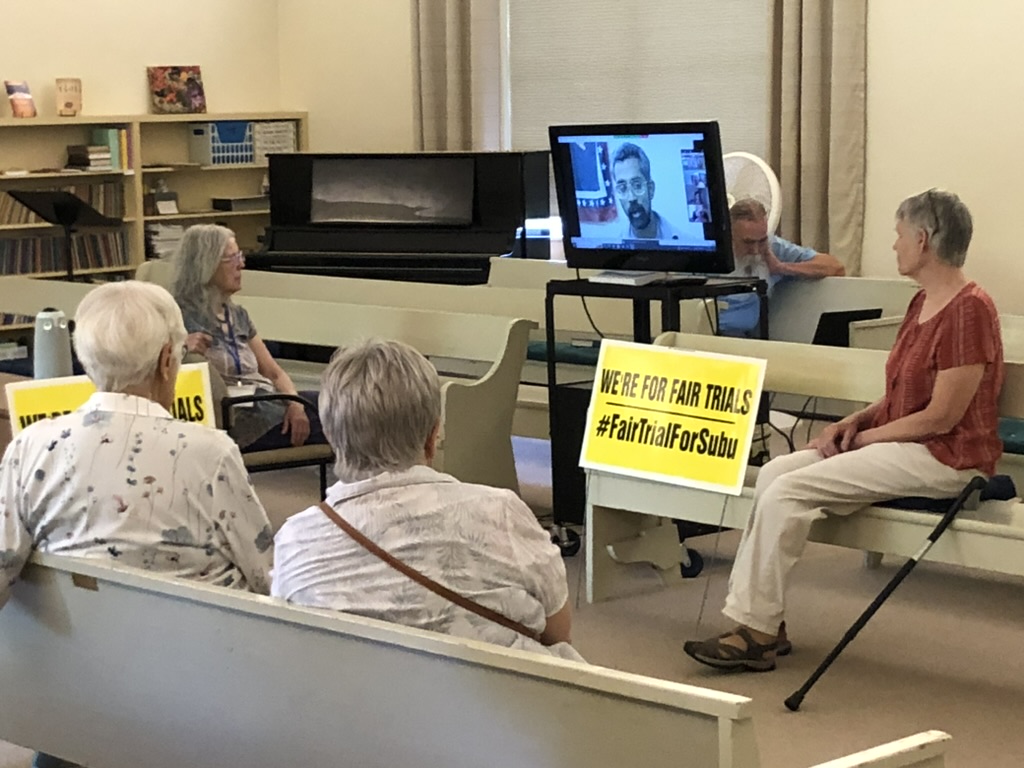Maybe you’ve seen the yellow yard signs around town: “WE’RE FOR INTEGRITY/ #FairTrialFor Subu.”
Subu is Subramanyam Vedam, four decades into a life sentence for the murder of his boyhood friend Thomas Kinser in 1980 – a crime Subu says he did not commit.
Next Monday, Subu’s lawyers will try to convince Judge Jonathan Grine that he deserves a new trial on grounds that evidence that might have led to an acquittal was suppressed at the time of his original trials.
The hearing begins at 10 a.m. in the Centre County Courthouse in Bellefonte. Subu’s supporters are expected to pack the house. Subu himself will participate remotely from prison.
Why reopen this cold, cold case after so many years?
Two years ago, Subu’s legal team, led by Gopal Balachandran, a Penn State law professor and State College borough council member, gained access to all the documents pertaining to “Commonwealth of Pennsylvania vs. Subramanyam Vedam.”
There they found multiple items that they say should have come to light at Subu’s first trial, in 1983, and his second one, in 1988.
One was an FBI ballistics expert’s measurements of the bullet hole in Tom Kinser’s skull.
The Commonwealth’s theory of the case rested on claims that Subu bought and test-fired a .25-caliber semi-automatic pistol a few weeks before Tom Kinser disappeared; that a .25-caliber bullet was found among Tom Kinser’s remains; and that the bullet and the casing from that bullet matched the casing from the bullet that Subu test-fired.
The FBI agent’s notes indicate that the hole in the victim’s skull was smaller than the hole that would have been made by a .25-caliber pistol. But at trial, he testified that the size of the hole was “not inconsistent” with the size of a .25-caliber bullet.
If jurors had been told the exact measurements, they might have disagreed – especially if they had seen another piece of evidence that caught Subu’s team’s attention: a sketch of the site at Bear Meadows where Kinser’s remains were found. Among the debris were casings from a .22-caliber handgun – a size that would be consistent with the holes in Kinser’s skull.
If Subu’s gun couldn’t have been used to kill Tom Kinser because the bullets would have been too big (Subu says he bought the gun after Kinser’s disappearance, not before) and there were no witnesses to the murder, Subu’s lawyers argue that there’s no proof that he was the murderer.
There’s more. Dan O’Connell, the guy who sold the gun to Subu, had a lengthy arrest record. The prosecution portrayed him as someone who was trying to straighten out. The case files contain evidence to the contrary. Had his record of more recent arrests been brought forward, the defense contends, the jury might have been less likely to believe him.
Finally, investigators identified several drug dealers who were potential suspects in the killing of Tom Kinser (Kinser owed money to some of them). In the case files are transcripts of interviews with some of these characters or people who knew them.
Had Subu’s original lawyers had access to those transcripts, his current lawyers contend, they might have used them to show that investigators were so convinced that Subu was the murderer that they didn’t probe deeply enough into other possibilities.
The Centre County District Attorney’s office response is that all this is too little, too late.
The prosecutors stand by the story that Subu shot Kinser with a .25.
They say jurors knew O’Connell was a bad actor and voted to convict Subu anyway.
They say none of the information obtained from Subu’s and Kinser’s acquaintances has any bearing on the case.
And they say that, in any event, all this should have been brought up a long time ago and the deaths and failing memories of key witnesses would put them at an unfair disadvantage in a new trial.
“I’ve reviewed the evidence,” District Attorney Bernie Cantorna told me, “and it supports conviction.”
Interestingly, Judge Grine did not have to grant Subu’s request for Monday’s hearing. The fact that he did so in the face of the DA’s opposition offers a bit of hope to those in Subu’s camp.
I am among them. Ever since I visited Subu Vedam in prison for the first time in 2014, I have been convinced that he does not belong there. And I find it hard to believe that, given the uncertainty about the murder weapon and the lack of witnesses, Subu’s guilt could be proven beyond a reasonable doubt, either 40 years ago, or now.
But let’s say I’m wrong. Two criminologists who’ve studied life without parole say it should be considered only when these conditions apply:
- there are multiple homicide victims
- the defendant “intentionally or knowingly caused the victim to suffer severe, protracted pain or psychological distress”
- the victim was below the age of 18
- the killing was planned in advance
- the defendant had a prior conviction and prison sentence for a felony-level crime of violence.
None of those conditions apply to Subu.
PREVIOUS COLUMNS ON SUBRAMANYAM VEDAM
• Life in Prison: It’s Not a Nice Place to Visit and You Wouldn’t Want to Live There
• A Mother Dies Without Seeing Her Son Go Free



